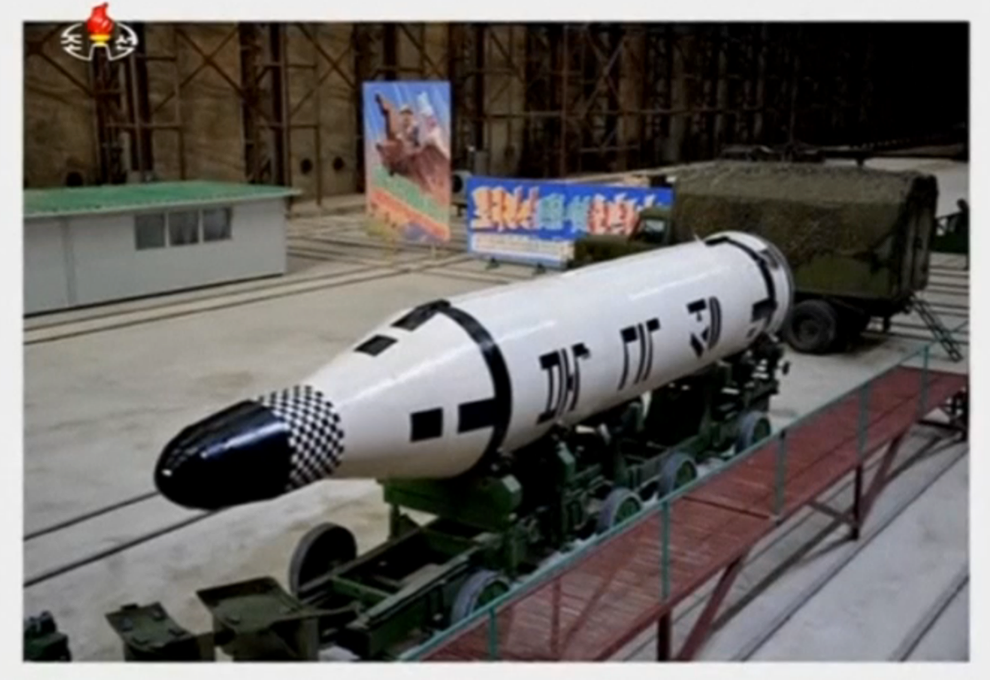
North Korea has now tested what appears to be a two-stage, solid-fueled ballistic missile capable of delivering a nuclear weapon to more than 1,000 km, probably much more. I would have thought that would garner some attention.
North Korea’s new ballistic missile, which the US calls the KN-11, is a technically submarine-launched ballistic missile. But there is nothing to stop North Korea from deploying it as land-based ballistic missile as well. In fact, that’s what China did with the JL-1 (deployed as the DF-21/CSS-5, left) and what North Korea did with the SS-N-6 (deployed as the Hwasong-10/Musudan, right.)
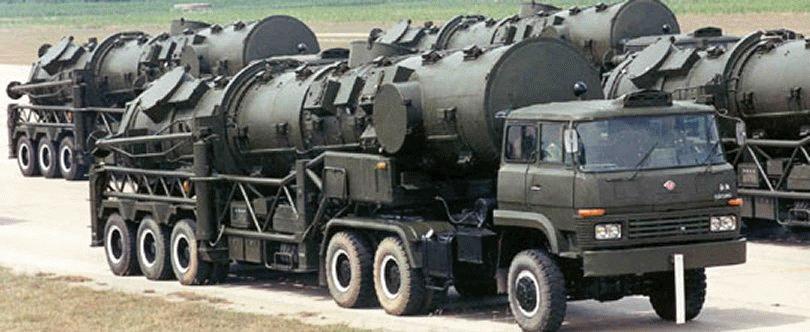
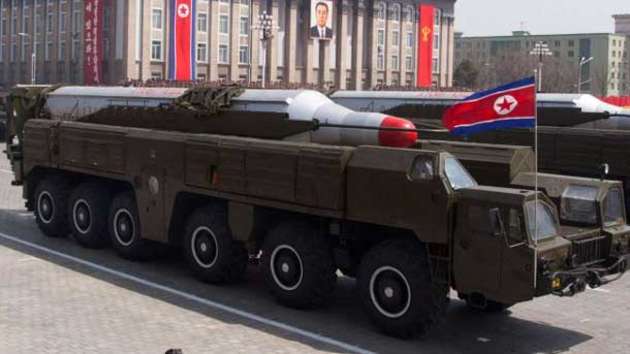
While press reports indicate that the KN-11 flew 500 km, take a look at the display being shown to Kim Jong Un. Like the most recent test of the Musudan, North Korea appears to have “lofted” the missile. In other words, North Korea fired it nearly straight up, reducing the range. If fired on a minimum trajectory, the KN-11 would have traveled much further than 500 km — over 1,000 km and probably much further. We’ll get to modeling the missile and its range, but at this point it doesn’t matter all that much.
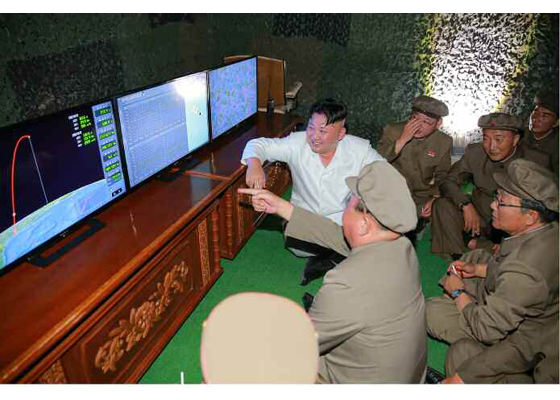
We know enough to know that this is, as Joe Biden might say, a big fucking deal.
The KN-11 offers North Korea a flexible system to threaten South Korea. For one thing, the missile is solid-fueled. Liquid-fueled missiles take a significant period of time to fuel and launch. Soviet units practiced to launch a Scud in 90 minutes, although the Iraqis reduced that time and demonstrated other measures to reduce detection. Solid-fueled missiles “significantly shorter reaction and reload time than existing Scud missiles,” a point made in 2007 when North Korea began deploying the short-range KN-02. That’s appealing to the North Koreans, although I would argue that it also drives the basic escalation dynamics on the Korea peninsula that worry me.
And once the missiles are launched, presumably in a salvo of several missiles, the KN-11 has additional advantages against missile-defense systems like THAAD. THAAD has a forward-looking radar with a 120-degree field of view. In the case of a single THAAD battery, North Korea’s submarines would not have to travel very far out to sea to attack the THAAD system from behind the field of view of its radar. I’ve made a map that shows the proposed location of the THAAD battery, its field of view, and the bases where its missiles submarines might be based. As you can see, a North Korean SLBM offers the opportunity to hit the THAAD site from behind. The rings show 500, 1000 and 2000 km from the THAAD battery.
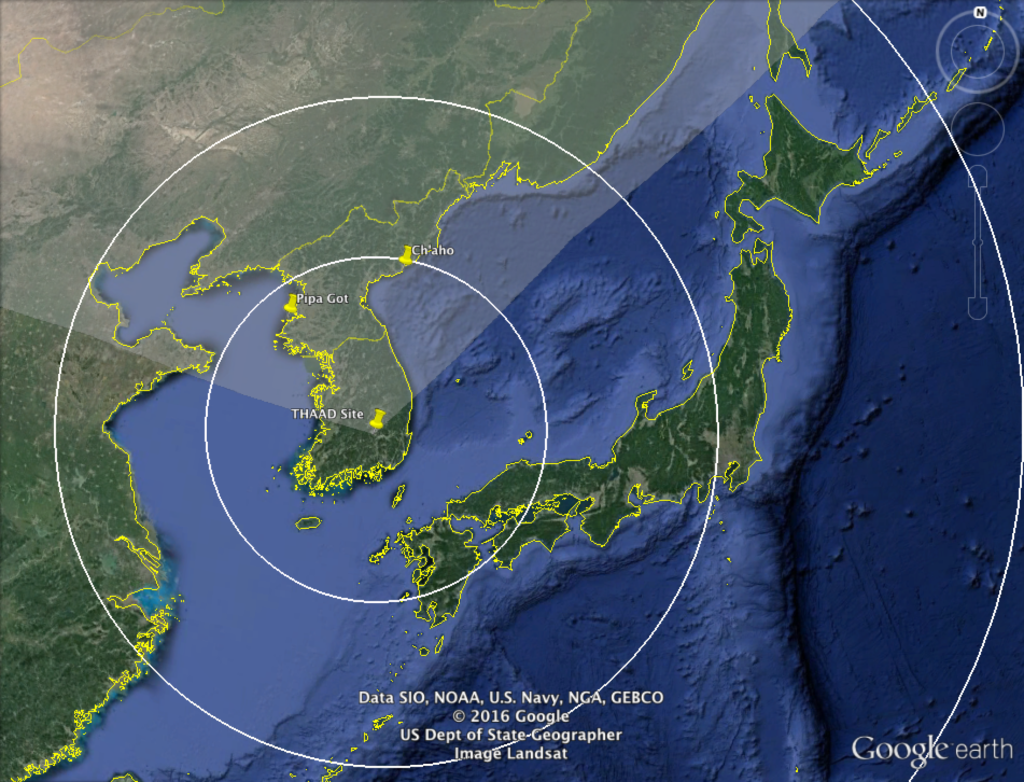
One obvious implication of this map is that South Korea needs two THAAD batteries to better cover ocean approaches. That is an obvious solution to at least part of the problem posed by the KN-11.
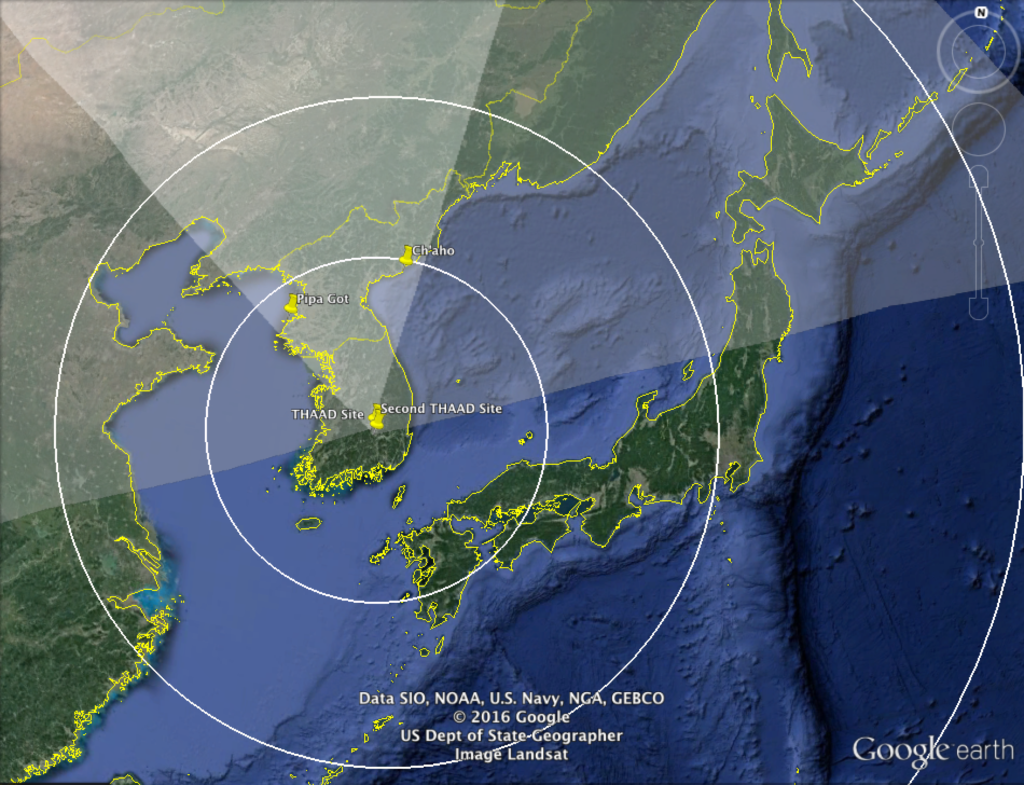
Of course, this does little to address the possibility of lofted attacks, which could be launched from the waters near North Korea’s naval bases — or from North Korea itself if a land-based variant is deployed. Lofting a long-range missile results in reentry at very high speeds and at a very severe angle. Whether THAAD can deal with a lofted KN-11 depends in part on the missile’s range. I don’t want to revisit debates about what used to be called “demarcation” between theater and national missile defenses, but I will observe that there was a healthy debate in 1990s about THAAD’s ability to intercept warheads reentering at higher speeds. THAAD is designed to intercept medium-range ballistic missiles (1,000-3,000 km in range) and in theory should have some capability to intercept intermediate-range missiles (3,000-5,500 km). But THAAD has never been tested against an intermediate-range target, let alone on such an unusual angle of attack. The Pentagon’s testing office, DOT&E, gives THAAD a good rating against MRBMs, but the lowest possible rating against IRBMs:
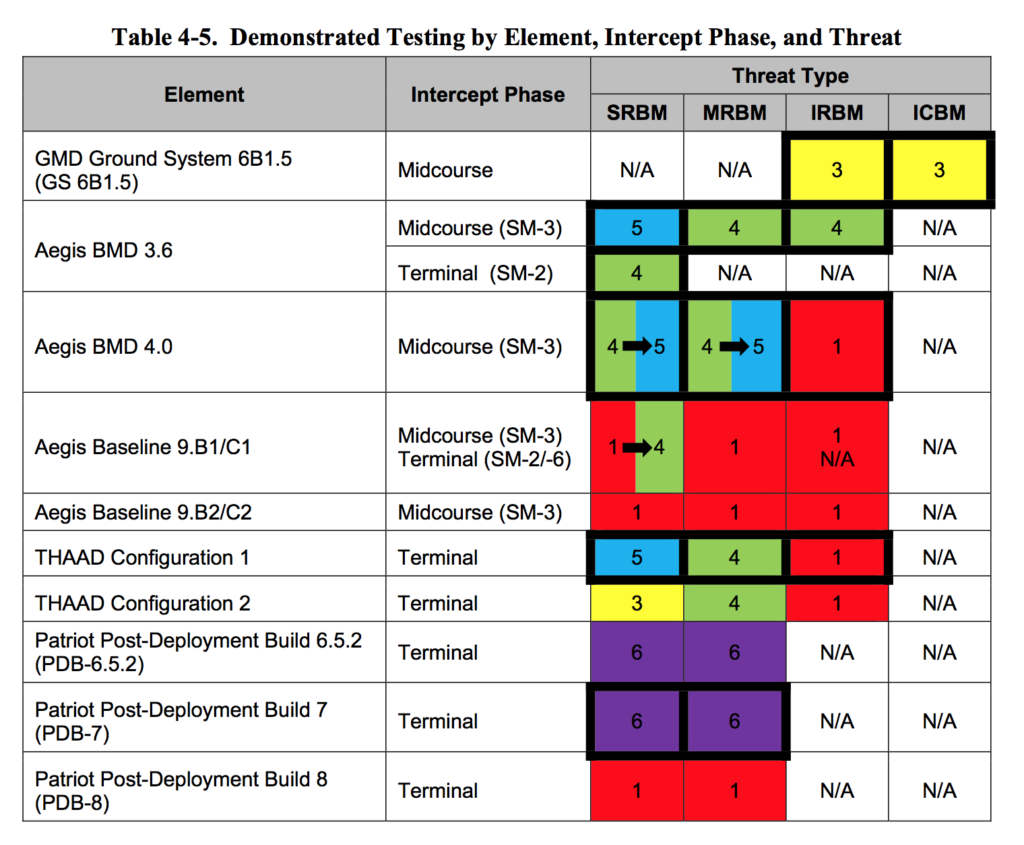
The effectiveness of THAAD will depend on the range of the KN-11, as well as how well THAAD handles the angle of attack. THAAT might be able to handle the KN-11, but it is distressing that North Korea can already present a threat that stresses defenses not yet deployed.
My broad point is an obvious one. South Korea has every right to defend itself against ballistic missile attack, both through THAAD and indigenous missile defenses. I don’t understand the public opposition to THAAD in South Korea. But even so, I don’t think we can arms-race our way out of vulnerability with North Korea. There are too many countermeasures available to North Korea defeat missile defenses. And, with nuclear weapons, North Korea doesn’t need a high success rate. One or two will do. Deploying defenses and precision-strike capabilities will intensify the arms race rather than provide an escape from it. So while I am sympathetic to those who recoil at the idea of sharing vulnerability with Kim Jong Un, don’t kid yourself: arms-racing only binds our fates more closely together. It’s a Gordian knot, where our best efforts to wriggle free of vulnerability only tighten the ropes. Our best option, unpalatable as it may be, involves finding ways to discourage North Korea from developing new capabilities. Defense is a far less effective strategy. This is a point I made a few months ago when I proposed the deeply unsatisfying solution of accepting North Korea’s liquid-fueled missile programs under the guise of its “space” program in order to head off the development of a solid-fueled missile program, a future that now seems to be here.

In an almost certainly intended irony, the North Korean name for this missile translates as “Polaris”, and it is nearly identical in size, configuration, and apparent performance to the first model U.S. Polaris missile. My guess is the “accuracy”, if we can call it that, is also similar. Imitation is said to be the sincerest form of flattery, but it was a dreadfully dangerous weapon of global concern when we developed it, and it still is.
Great piece. FYI, here’s what MDA told me when I asked them about THAAD’s capabilities re: SLBMS: “The specific capabilities of THAAD to defend against any particular threat will depend on variables such as location, range and threat capabilities. For security reasons, we will not publicly discuss specific operational employment scenarios.”
And the concern goes beyond THAAD vs SLBMs in the Korean AOR. From a 2013 SASC hearing (http://nukesofhazardblog.com/quote-of-the-day-independent-senator-thinking-independently-about-missile-defense-edition/):
SEN. KING: One of the issues that I’ve been concerned about as I’ve been in these hearings is a growing submarine capability. It seems like everybody wants to have a submarine and a lot of countries do. I take it that this shield that we are constructing and have constructed would be effective against a submarine-launched missile which could be much closer.
How do we deal with a submarine-launched missile that would be a couple hundred miles off shore? Is that a different — is that a different issue and, again, it gets back to this East Coast issue. I can’t see how we could get a shield missile — an interceptor from Colorado or Alaska to protect the East Coast against a missile that’s launched from within 500 miles of the coast. Talk to me about submarines.
GEN. FORMICA: Actually, Senator, my assessment is that the ballistic missile defense system that’s in place and designed against an ICBM — a limited ICBM threat from North Korea and Iran.
SEN. KING: Not submarine-launched missiles
GEN. FORMICA: Not submarine-launched.
SEN. KING: What is our strategy with regard to submarine- launched missiles?
GEN. FORMICA: I’d have to take that for the record. We don’t have it. We don’t have a strategy. NORTHCOM commander has obviously identified that kind of threat as a concern and that is an area that he is concerned about.
SEN. KING: Madame Secretary?
MS. CREEDON: I just want to jump in for a minute. I think we probably should get you — this is a very complicated topic, to say the least.
SEN. KING: I’m figuring that out.
MS. CREEDON: And it isn’t just ICBMs. It’s also cruise missiles. But why don’t we make the offer to get you a briefing on some of the issues and complexities associated with a submarine threat off the coast, either coast of the U.S.?
SEN. KING: Absolutely. Well, I just — you know, I’m just trying to think like the enemy here. If you guys can stop intercontinentals, then I’m going to bring them in in another way. Of course we can have a whole different discussion about one that comes in in a suitcase into New York Harbor. But OK, well, I think that’s it, Mr. Chairman. Thank you.
The April 2016 SLBM test of DPRK went only 30 kilometers but was a success as DPRK claimed . A discussion and comparison of rocket exhaust of Pukkuksong-1 ,Chinese JL-2. and Russian Bulava would be appreciated.
Rodong Sinmum picture #17 of Pukkuksong launch shows the unusual trajectory on screen monitor .A red line rising then curving down toward the ground finally changing to white line during last part of descent. I assume the red line trajectory was the powered flight . So was part of the trajectory powered toward the ground in final stage of powered flight? It was not a demonstration of maximum range at all.
Is there any consensus on whether this most recent test was fired from an actual submarine or an underwater test barge?
Kim Jong Un hugs his men when the SLBM is successful . That says a lot with his nonverbal actions.
I agree. That’s real joy.
For various reasons we think the submarine is probably launching it.
submersible test barges (soviet, french) never fire missile, just conduct pop-up tests.
north koreans follow soviet test pattern: following dummy pop-ups with real missile tests from a specially designed test sub.
Nicky
Did the Chinese supply this missile? Did NK make a copy?
http://www.koreatimes.co.kr/www/news/nation/2016/09/485_213300.html
I doubt it. I certainly don’t see any evidence that would support that conclusion.
This missile should put to rest the noise that the North Koreans are always getting sub rosa help. Look at the public history of these SLBM tests. They couldn’t make the Russian concept of a liquid fueled SLBM work, even with example Russian subs and missile engines in hand, so they refocused on the American concept, which, apart from the requirement for advances in solid fuel technology, is probably a lot easier to make work. They made a point of showing us they had the requisite solid fuel engine, didn’t they? The general parameters of the 1st generation U.S. Polaris are well known in open literature. These guys are dead serious about their “juche”, and mocking them only seems to make them double down.
The DPRK claim to have their own style in both missiles and nukes. The SLBM probably started in 2003 with inclusion of DPRK in “Axis of Evil” allegation of Bush. DPRK did not get here overnight .They worked on it 65 years and were always the most motivated country in the world after Korean conflict genocide.
Mark, Does your phrase “Korean conflict genocide” refer solely to genocide by the North Korean government against both North and South Koreans during the Korean war conflict many decades ago? Or does it also refer to the subsequent and continuing genocides committed by the North Korean government against North Koreans? How does your reference to genocide explain North Korea’s motivation to seek missiles and nukes?
The question to me is the development cycle: where is the technology coming from? Comment on Bruce Bechtol claim here on Chinese sourcing?
http://english.chosun.com/site/data/html_dir/2016/09/05/2016090500881.html
Totally unpersuaded by that.
I find this conversation bizarre. North Korea began deploying a short-range solid-fueled ballistic missile ten years ago. The idea that, in the intervening decade, no progress would be made baffles me. It seems obvious that this technology, which South Korea acquired in the late 1970s, is held in North Korea. Looking at solid-fueled missile programs in Iraq, Argentina and Egypt should serve as warning that this technology isn’t so fancy. (Notice the sparking during the launch. Not pretty, but a helpful indication of probable North Korean handiwork.)
As for the claim that the missile resembles the JL-1, that is because virtually all two-stage solid-fueled look the same in terms of size and proportion. The KN-11, French M2/20, and JL-1 all owe a debt of gratitude to Polaris. Solid-fueled missiles tend to look more alike than liquid fueled missiles since they have fewer distinguishing features than liquid-fueled missiles, which have ports that reveal tank ratios and so on.
KN-11 is not a JL-1. JL-1 is very close to a Polaris A3 in size and configuration – four gimbaled rocket nozzles per stage, compact / tightly packed base and top, short interstages, no thrust vector vanes, etc.
KN-11 has one nozzle on the first stage (at least, and indications on the second if we read photos right). It has clear signs of thrust vanes, indicating the nozzle does not gimbal. The base of the first stage and the interstage between the first and second stages are huge by comparison to Polaris A3 or JL-1 – single nozzle makes for 2x as long nozzle, and there’s say 30-50 cm more in thrust vanes beyond the nozzles…
How does Pukkuksong-1 first stage compare to Houwteq RSA-4 first stage ?
I was most struck by the apparent presence of a set of grid-fins in the back of the missile. As to systems coming out of a launch tube this is an odd/poor design choice.
http://38north.org/2016/08/slbm082616/rodong-sinmun_2016-08-25-01-03/
Actually SLBMs make missile defenses nearly entirely irrelevant. The big problem is attribution and discerning the appropriate home address for the appropriate response. THAAD presence or absence is immaterial.
They don’t make missile defenses entirely irrelevant; an Aegis Ashore can see and shoot in any direction.
But THAAD is directional.
8-/
George; the point is to shoot where the defenses aren’t. Aegis Ashore still has the cool 1970s air defense AN/SPY-1 radar and its pretty anemic as regards BMD performance. I suggest a reasonable read of the 2003 APS, 2011 DSB and 2012 NAS/NRC studies will convince you that the primary role of that radar is as an expensive radio to talk to the SM3 missiles. A hard look at the AMDR should convince you that a radar that can back-fit into the same support as the AN/SPY-1 isn’t going to be orders of magnitude better either.